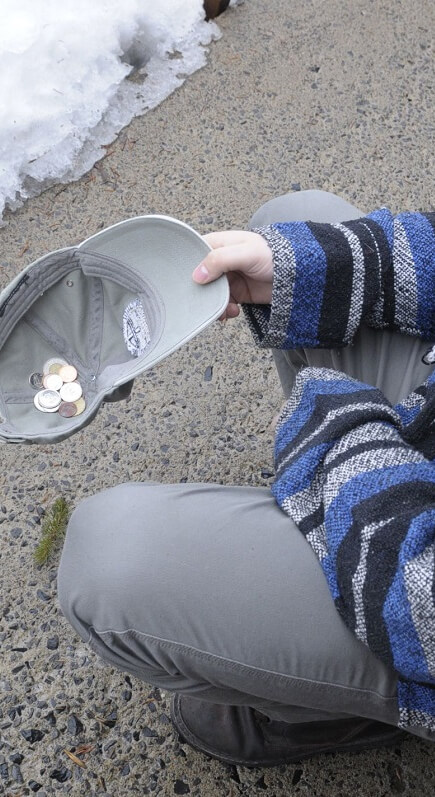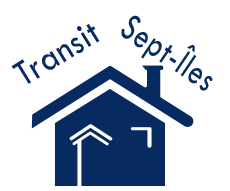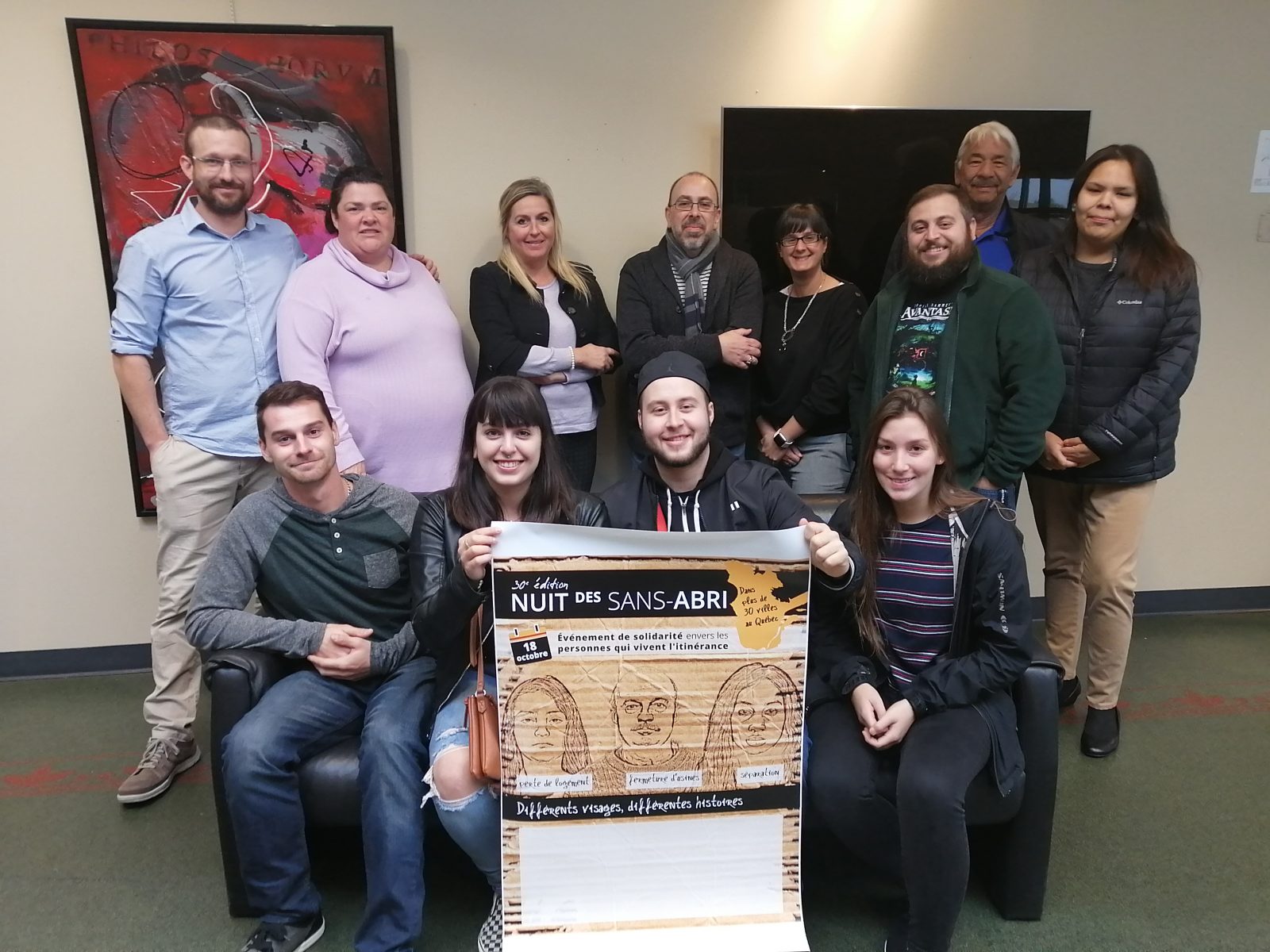
Fight against homelessness
Transit Sept-îles’s mission is to fight homelessness through its actions and awareness-raising activities. Among these actions, the Night of the Homeless can reach many people and make them aware of the cause. For four years now, several organizations forming the committee, have organized this night as a festive evening with musical groups, hot pastries and beverages as well as barrel fires. The event takes place every year on the 3rd Friday of October in more than 40 cities in Quebec.
This year in 2019, nearly 250 people walked on the floor of the Shaputuan Museum. In addition to the fact that this night is a vigil of solidarity for all Quebecers who sleep on the street, we take advantage of this event to deliver other messages. We offer you a free outdoor show to thank you for being so generous all year long. This time, it’s the organizations that give you, so come on, it does not cost anything! We also aim to make this evening an example of working together with the Aboriginal community who are also affected by homelessness. We want to set an example for the rest of the province, because for us forgiveness is about acts, not words. Thank you to the incredible contribution of the Sept-Îles Native Friendship Center, which brought a touch of magic to the event.
Homelessness in Quebec
Description
Québec’s national policy to fight homelessness – Together to avoid and get off the street (Politique nationale de lutte à l’itinérance – Ensemble pour éviter la rue et en sortir) defines homelessness as being “a process of social disaffiliation and a situation of social exclusion characterized by a person’s difficulty in having a stable, safe, adequate and healthy home due to a lack of housing or his or her inability to maintain one and, at the same time, in maintaining functional, safe and stable relationships in the community. Homelessness is explained by a combination of social and individual factors that constitute the life experience of men and women”.
According to this definition, homelessness is a process that causes someone to live increasingly on the fringes of society. This process is called “social disaffiliation”. It is this gradual withdrawal caused by an accumulation of events in the course of a person’s life that leads him or her to break ties with the people and resources.
According to this definition, homelessness is a process that causes someone to live increasingly on the fringes of society. This process is called “social disaffiliation”. It is this gradual withdrawal caused by an accumulation of events in the course of a person’s life that leads him or her to break ties with the people and resources.
Homelessness is also characterized by difficulty in maintaining relationships with others and participating actively in society. The feeling of having a home surpasses the fact of having a place to live. It is a feeling that is at the core of a person’s needs and helps him or her to feel good and develop self-esteem and self-confidence. This encourages participation in society and in relationships with those around him or her. Not having a home is much more than just being without shelter for the night.
How does one become itinerant?
We are not born itinerant, we become it. Homelessness is the culmination of a process of disaffiliation. This process is very frequently marked by multiple breaks, dead ends and difficulties that lead to the degradation of social ties. Understanding this process leads us both to understand the vulnerability of some people and to recognize the social mechanisms that lead to homelessness: disqualification, exclusion, discrimination, violence, lack of support, fragmentation of family ties and intervention too much. late or too tenuous that can not counter the marginalization. The factors contributing to this process of disaffiliation often add up in the lives of people at risk.
Types of homelessness
The duration and frequency of homelessness varies according to people and factors that lead to that situation.
There are generally 3 types of homelessness:
- Situational homelessness: A situation in which people are temporarily without a place to live but who manage to find one after experiencing some time without shelter. This is the most common type of homelessness
- Cyclical homelessness: A situation in which people alternate between periods of having a place to live and living on the street.
- Chronic homelessness: A situation in which people have not had a place to live for a long period of time. This is the most visible type of homelessness. Although less common than situational homelessness, it generates a lot of interventions and significant social costs
Social factors
The main social risk factors for homelessness are the following:
- Poverty
- Difficulty or inability to access clean, safe and affordable housing
- Social isolation
- Difficulty reintegrating into the community after spending time in an institution (hospital, prison, etc.)
Risk factors
It is often the accumulation and interaction of many factors that can lead someone to experience homelessness.
The risk factors of homelessness can be:
- Social factors
- Individual factors
However, not everyone who presents with these risk factors will necessarily end up homeless.
Individual factors
Certain factors particular to individuals and their life trajectories can lead to homelessness. The main individual risk factors are the following:
- Having already experienced homelessness
- Psychological problems, including a fragile mental health
- Physical health problems
- Intellectual or physical deficiency
- Addiction to alcohol, drugs or gambling
- Isolation
- Certain life events, such as:
-
- Bereavement
- Family problems
- Separation (a breakup or estrangement from one’s community, for example)
- Physical and psychological negligence
- Abuse
- Repetitive stays in protection and rehabilitation services for youths in trouble of adaptation or foster families during childhood
- Running away from home repeatedly
- Dropping out of school
- Domestic violence or sexual assault
Prevent homelessness
It is possible to act before a person is on the street, but for many people, mostly men, asking for help is very difficult and the call for help is used as a last resort unfortunately. That’s why we ask you to pay attention to the signs, and if you want to intervene, do it. Accompany this person to front-line services before it is too late. Often, it can be a person who abandons himself. We can see signs such as non-payment of bills, accounts, she no longer has contact with relatives, does not go out of his house, consumes much more than usual, etc … Many people who come knocking at our door are people who have not been treated for a simple depression; it’s surprising is not it? We can lose everything if we do not ask for help and find it on the street today, it can happen to everyone.
Support
Lorem ipsum dolor sit amet, consectetur adipiscing elit, sed do eiusmod tempor incididunt ut labore et dolore magna aliqua. Ut enim ad minim veniam, quis nostrud exercitation ullamco laboris nisi ut aliquip ex ea commodo consequat. Duis aute irure dolor in reprehenderit in voluptate velit esse cillum dolore eu fugiat nulla pariatur. Excepteur sint occaecat cupidatat non proident, sunt in culpa qui officia deserunt mollit anim id est laborum.
Ensure the essentials
Lorem ipsum dolor sit amet, consectetur adipiscing elit, sed do eiusmod tempor incididunt ut labore et dolore magna aliqua. Ut enim ad minim veniam, quis nostrud exercitation ullamco laboris nisi ut aliquip ex ea commodo consequat. Duis aute irure dolor in reprehenderit in voluptate velit esse cillum dolore eu fugiat nulla pariatur. Excepteur sint occaecat cupidatat non proident, sunt in culpa qui officia deserunt mollit anim id est laborum.
Break social isolation
Lorem ipsum dolor sit amet, consectetur adipiscing elit, sed do eiusmod tempor incididunt ut labore et dolore magna aliqua. Ut enim ad minim veniam, quis nostrud exercitation ullamco laboris nisi ut aliquip ex ea commodo consequat. Duis aute irure dolor in reprehenderit in voluptate velit esse cillum dolore eu fugiat nulla pariatur. Excepteur sint occaecat cupidatat non proident, sunt in culpa qui officia deserunt mollit anim id est laborum.
Build unifying living environments
Lorem ipsum dolor sit amet, consectetur adipiscing elit, sed do eiusmod tempor incididunt ut labore et dolore magna aliqua. Ut enim ad minim veniam, quis nostrud exercitation ullamco laboris nisi ut aliquip ex ea commodo consequat. Duis aute irure dolor in reprehenderit in voluptate velit esse cillum dolore eu fugiat nulla pariatur. Excepteur sint occaecat cupidatat non proident, sunt in culpa qui officia deserunt mollit anim id est laborum.



